Your Cart is Empty
spend R1000. 2kg or less. free shipping.
Menu

spend R1000. 2kg or less. free shipping.
bonsai
gardening
Orchids

The Art of Fertilizing
17 min read
As the response was so good to a previous blog on one of the most basic of bonsai techniques which must be grasped, "The Art of Watering," I thought I would tackle another area of bonsai which receives a lot of attention and quite deservedly so.
Feeding is one of those skills, and yes it is a skill but more about that later, which some are either completely ignorant of the need to perform or at the opposite extreme artists who make somewhat of a science of it. My goal is to be somewhere in the middle..
The need to feed
I guess the first point which should be discussed is the need for feeding in the first place, before we get into the details.
In conversation with some people I have realized that they either do not feed their trees, or if they do it is very seldom or its done in a completely haphazard manner. So let's just bust that myth right now, depriving a tree of fertilizer does not make it a bonsai! It will make for a very weak and sickly tree in a pot though!
depriving a tree of fertilizer does not make it a bonsai.
Although there are certain goals which may require that you withhold fertilizer at times during the growing season, generally one needs to ensure your trees are well fed if you wish for them to respond well to the typical cultivation techniques we apply to them.
For example, if you neglect to feed a tree in spring and possibly even in autumn of the previous season, would it really be reasonable to expect that should you completely defoliate that tree, it is likely to respond with a second flush of growth and continue growing healthily through the season? I am sure you will agree that the answer is "no." If you disagree you definitely need to read further.
When we provide fertilizer to a living plant it will respond in some way to the nutrients. There is no easier example to use than flowering plants which may be given certain fertilizers which are said to promote flowering at certain times of the year when the flower buds are developing. We could therefore describe this fertilizer as one which promotes flowering. Other fertilizers promote fruit yield or simply just vegetative growth.
What is a balanced fertilizer?
In order to answer this question we need to understand that all fertilizers are classified according to their NPK value or ratio. NPK fertilizer is primarily composed of three main elements: Nitrogen (N), Phosphorus (P), and Potassium (K), each of these being essential in plant nutrition and could be described as the basic building blocks.
The role of each building block
The main building blocks
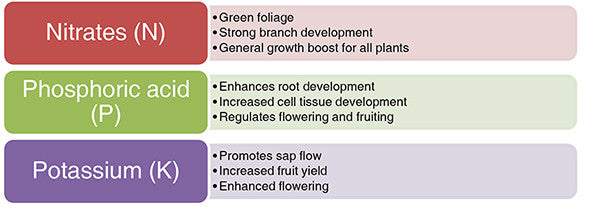
The above graphic shows the basic building blocks and the purpose or primary roles they fulfill. Extracted from my beginners e-book.
Trace elements
Aside from the main building blocks, plants also need a supply of trace elements too. Very often these trace elements naturally occur in soil and other organic mediums but as bonsai is moving over towards a soil-less, modern growing media these trace elements will likely not be found and where they are, they may be rapidly depleted with frequent watering and due to the plants consumption. Thus it is important that these trace elements are made available to your trees through the fertilizers you provide.
(Trelmix is a product I would recommend for trace elements)

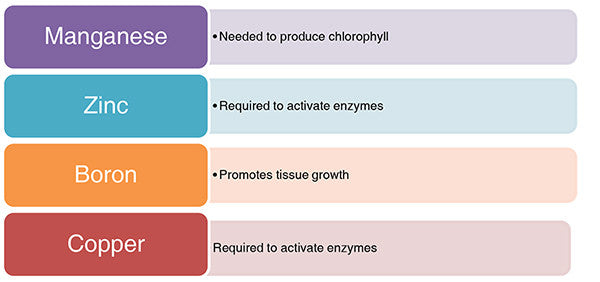
Extracted from my beginners e-book.
How much is enough?
In a later paragraph of this post we will discuss "Feeding with purpose" which introduces the concept of feeding for the various stages of bonsai development. However the quantity of fertilizer is largely related to the season and also to the species.
Concentration or dosage
Should you ever be in doubt regarding the dosage of a fertilizer simply read the directions on the bottle or packet. There is no magic or secret dilution ratio the manufacturer is withholding from you. It is likely that increasing the concentration or dosage substantially will result in more harm than good, burning your roots or other undesirable consequences. There is a saying; "Feed weekly, weakly." I like that, but it only applies to liquid fertilizers.
Some fertilizers will actually direct you to take some precautions. For example the 1-for-all organic fertilizer pellets should not be used on recently repotted trees. I would therefore also avoid using it on recently collected yamadori. I imagine the reason the manufacturer has provided this warning is as this inorganic (chemical) fertilizer contains a high amount of nitrogen and although this might be great on healthy, growing plants it may burn tender roots.
Seasonal Feeding
Spring
Spring is the time of year when everything is growing so any nutrients in the growing medium you have your tree planted into is going to be depleted and will need to be replenished.
Young developing trees should be fed from the beginning of the season, including all pines as we want them to get as much nutrients so when they are decandled they will respond well. More mature or refined trees should not be fertilized yet though, and it is better to wait a couple weeks till the spring leaves begin hardening off before beginning to fertilize them. If using solid fertilizers such as BonsaiBoost then perhaps you might only add one sachet and after a week add another, and so forth.

Image caption. A Chinese maple in late spring after the new growth has hardened off.
Summer
In summer, depending on where you are situated in the country and whether your environment is tropical or not; your trees growth may either slow tremendously or stop altogether due to the heat. It therefore makes sense that feeding during the height of summer when the temperatures are at their highest is not really necessary. I forget the precise temperature at which fertilizing makes little sense, but I guess when you see your trees go into a state of stupor like most of us when its that hot, then is when you no longer need to feed. When the temperatures drop again you can resume, and you will usually see your trees will respond with another growth push, although it will not compare with that of spring.
Autumn
This is a very important time of the year to be feeding. Why? Well because it ensures that your trees build up a store of nutrients with which to jump start growth in the following spring. If you have a Japanese white pine then you would know that autumn is actually the ONLY time in the year that they are fertilized, barring a few exceptions as usual, but this is as it is the method used to manage needle length (as these trees are not subjected to the same decandling techniques which double flush, two needle pines are).
Tip! I every now and then hear of someone advocating the use of low or zero nitrogen fertilizer in autumn. The logic is that you do not want to catalyze growth in your trees at a time when they should be shutting down. Very sound logic yes, but it omits the fact that all plants require all 3 of the core fundamental building blocks in the NPK ratio for normal cell processes to occur. Thus one can deduce that using a fertilizer in which nitrogen, phosphorus or potassium has been eliminated or provided in almost trace amounts will limit the plant's ability to function correctly and this does not imply foliage growth exclusively but all functions. Rather provide a balanced, moderate fertilizer whenever fertilizing.
Winter
In winter trees become dormant and growth is either negligible or none at all. Once again this will depend on your local climate, but if your trees have a dormancy period then they are not going to need fertilizing and any that you do apply will simply be wasted. I also understand that in regions which become very cold in the winter that the processes which break down organic fertilizers into a form which root hairs can absorb cease activity, so yet another reason to stop fertilizing during such periods.

Image caption. White pines are usually only fertilized in autumn.
Knowing your species
Just as some humans seem to need more food that others, so do our trees. Generally this is the case with anything which grows vigorously. Species like the Australian Brush Cherry or Syzygium and the Wisteria vine come to mind, but there are many others. Both these plants grow extremely quickly and thus can deplete nutrients in their immediate environment rather quickly. In a confined space this depletion will be that much quicker. In some plant care notes it will be stated that a certain species is a gross feeder or something similar but not always. So very broadly speaking, if the tree is often used as a hedge such as the Brush Cherry mentioned above, privet, kei apple, firethorn and others then it is probably a species which requires a lot of food.

Image caption. To get certain species to bear fruit requires skill but also lots of fertilizer.
On the other hand overfeeding a tree which is not going to take up the nutrients provided to it is simply a waste of money, although I am sure any plant which might be growing below your benches will enjoy it.
It is usually good practice to fertilize your flowering trees after they have finished flowering. Fertilizing at other times of the year when these plants are developing flower buds may result in more than desired foliage growth, and cutting this growth would mean sacrificing the flower buds. However plants such as bougainvillea and flowering quinces flower for months on end so these plants need to be treated a little differently and it is best to give them weak fertilizer throughout this period.
Tip! It is advisable to reduce the stress of flowering and fruiting on certain species such as azalea, crab apples and firethorns for example by eliminating the flowers and fruit almost entirely and only allowing them to flower or fruit in abundance every few years.
Signs of deficiency and excess
| Nutrient | Deficiency | Excess |
| Nitrogen | Yellowing of the leaves. Little new growth. Poor fruit growth | Very dark green leaves that are very thin or weak. Excessively long internodal distances. Plants are generally less insect, disease and drought resistant. |
| Phosphoric acid | Weak root system, which is under developed. This causes stunted growth above the soil. | Micronutrient deficiencies can occur such as those of iron and zinc. |
| Potassium | Flowers and fruit are small/under developed. Old leaves turn yellow, then brown and then die. | An excess negatively affects magnesium and calcium uptake. |
| Calcium | The tips of fruit blacken and then rot. Reduced growth of fruit. | Causes micronutrient deficiencies such as those of magnesium and potassium. |
| Magnesium | Veins of the leaves turn yellow | Unlikely as plants can tolerate high amounts. |
| Sulphur | Entire plant begins to turn yellow and growth is retarded. | Premature dropping off of the foliage. |
| Iron | Veins of leaves turn yellow | Leaves turn a bronze colour. Small brown spots may be present on the leaves. |
| Manganese | Young leaves are damaged. Veins of leaves turn yellow. | Brown spots can be seen on the leaves. |
| Zinc | Leaf size is smaller than usual. | Usually results in deficiencies in iron |
| Boron | Can lead to the breakdown of plant tissue; growing tips can die; leaves are often deformed. | Tips of leaves become yellow, then die and fall off. |
| Copper | The leaves are reduced in size. | Results in an iron deficiency |
Extracted from my beginners e-book.
The table above is not the "final word" on the subject when it comes to identifying incorrect fertilizing practices. It can be misleading if you merely look at the symptoms very narrow mindedly above. For example, browning leaves may be a symptom of too little or too much water, yellowing leaves might be indicative of too much or too harsh sun. Neither observation has anything to do with fertilizing. Instead you need to look at the entire tree, ask yourself questions about the manner in which it is maintained and no doubt rely on past experience. Failing this, take your tree along to a club meeting or to your local bonsai nursery for some input also.
Feeding with purpose
Stage 1: Growing material
In the initial stage of bonsai development; perhaps a seedling, a rooted cutting, a successful layering or other, our focus should be getting it to grow as healthily as possible. The aim of growth at this stage is to produce a thick trunk. One can use field growing techniques for this {read more about that here} or over-sized containers.
Fertilizer needed during this stage should be balanced but perhaps one which favors Nitrogen, the building block for vegetative growth. I believe the secret is not so much the exact ratio of NPK but rather that the plant has a sustained supply of it. Some fertilizers rapidly release their nutrients leaving the plant unfed for weeks until more fertilizer is applied. A slow release type of fertilizer is ideal.
Feeding lots of nitrogen rich fertilizers will produce leggy growth, which has long internodal distances (the distance between two nodes or buds). However this is not a problem at this stage as the more the branches elongate the thicker the trunk will become and this is our only goal for now, we are not interested in branch formation yet.
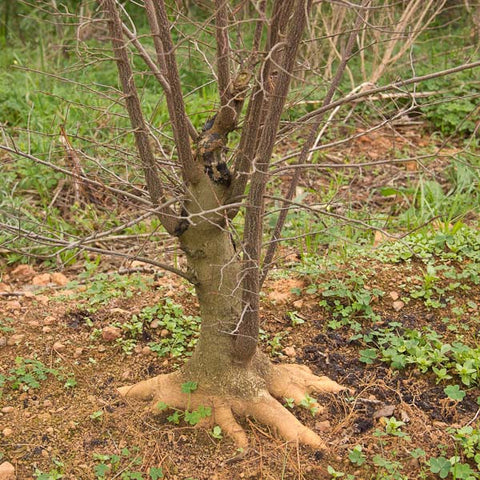
Image caption. When field growing you want to feed generously.
Stage 2: Branch structure
After you have achieved the trunk which you want or need for a design you have in mind we move into the next stage; branch structure or formation {read more about branch structure here}. Now I do not mean to suggest that the one stage ends and the other begins, with a clear start and finish, it is certainly possible to develop the first sections of a branch when the tree is still in the ground or in its over-sized container. However as growth is rather rampant during the first stage, unless you are able to keep an eye on it, the branches which you do develop might be too coarse and out of proportion to the trunk. It is therefore best to develop branches in a slightly more controlled manner, however it will speed up the process if you do perform some branch development on trees with particularly thick trunks while they are still in the field.
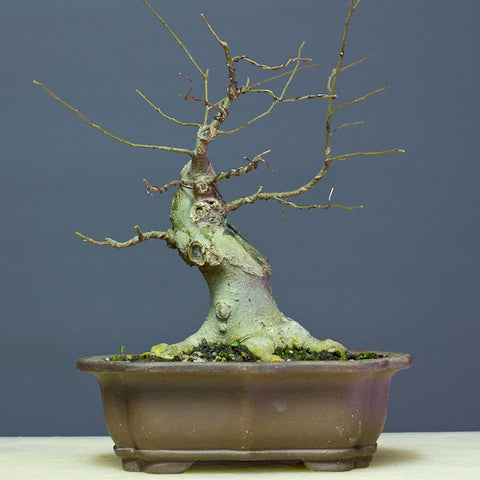
Image caption. During the basic branch structure stage you want growth but it must happen in a more controlled manner.
Stage 3: Ramification
Ramification of course is where you now have developed a basic branch structure on your tree and you are now starting with the secondary branches which create the volume to the foliage canopy or pads. At this stage it is more critical what you feed your tree [and what it is growing in] as excessive feeding will result in very long internodes and this is very undesirable now as it will limit the amount of fine twigs you can grow or support in the region or zone of the outline or silhouette of the canopy. Too little fertilizer is also no good as the tree will weaken and it will not react to defoliation, a key technique needed when developing ramification {Read more about it here}.
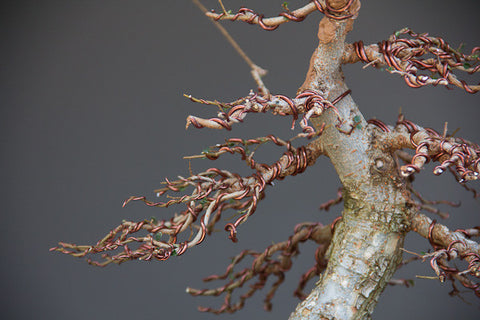
Image caption. Timing and concentration of fertilizer becomes more important when working on the ramification of your trees.
Stage 4: Refinement and Maintenance
In this fourth and final stage of the development of a bonsai tree, you want as little growth in the tree as possible but you need to maintain it in ideal health or it will be subject to diseases and insect attack. Incorrect fertilizing is also likely to lead to branch die-back - where small twigs simply stop growing, particularly evident in spring. The solution to this challenge does not lie exclusively in good fertilizing technique but also relies heavily on the growing medium you're using.
Tip! In spring, trees which are still in stage 1 will be fed generously from the beginning of the growing season. However fertilizer applied to trees in stage 4 will be withheld for a few weeks until that initial burst of growth has slowed, or you will encourage too much growth and thereby lose delicate branches as they will become too coarse.
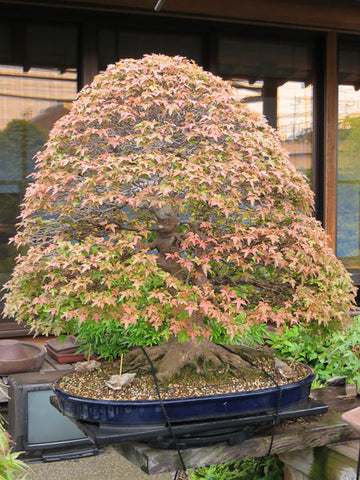
Image caption. When a bonsai has reached a stage of maturity like this stunning Maple at AichiEn belonging to the Tanaka family, then you need to keep it healthy but want to prevent any unnecessary growth.
Types of fertilizers
There are many fertilizers and growth enhancers on the market today. Depending on your preference you can select from chemical or organic fertilizers.
There is no hard and fast rule when it comes to selecting a fertilizer. You will first need to decide if you have a preference for organic or chemical, or perhaps you don’t mind. From what I have seen the vast majority of bonsai growers use organic fertilizer, and for good reason.
Products sold to replenish trace elements are not fertilizers so I do not discuss them in any depth below. Trelmix is the product I would recommend for trace elements though, it is a very well known product in the South African market and I can also personally vouch for its efficacy.
Chemical fertilizers
The danger when using chemical fertilizers is that it is possible to overdose the plant and cause root burn or other harm. However by simply following the directions of the package or even diluting the fertilizer further you can easily avoid this.
In general it is actually recommended that you dilute the fertilizer more than recommended as it is better to feed more frequently than as directed on the packaging. As you water your bonsai on a daily basis any liquid fertilizers will quickly be leached from the bonsai pot. Therefore by feeding more frequently, in lighter doses, you will ensure your trees always have food available to them.
Chemical granules
When using chemical granules like 2:3:2 or 3:1:5 be sure to use a very small amount. When these granules begin to dissolve they can release a lethal dose of chemicals which can burn.
However granules are very useful when used correctly, as they are a slow release approach to fertilizing, meaning that not all the fertilizer is made available to the plant immediately but rather over a period of time.
Organic fertilizers
Organic fertilizers, as the name suggests, are generally made from organic sources such as kelp, fishmeal, chicken manure and more. However several organic fertilizers are now being fortified chemically with trace elements or other nutrients, which are difficult to find in sufficient quantity, organically.
Unlike chemical fertilizer it is virtually impossible to overdose with organic fertilizers. The reason for this is that generally they are not as concentrated.

Image caption. BonsaiBoost is based on a recipe which my teacher uses and has been used in Japan for many centuries. Completely plant organic with no animal byproducts in it, it is the ideal organic fertilizer which is suited to all species of bonsai.
Liquid organic
Liquid organic fertilizers are easy to use and carry very little to no risk of overdosing if applied according to the directions.
When watering daily you will be flushing the nutrients from the soil so it is advisable to fertilize often, weekly if possible, in order to ensure the tree has sufficient nutrients available to it at all times during the growing periods. Feeding weekly means you must however dramatically increase the dilution ratio, adding more water than instructed to.
Tip! Never apply fertilizer to a dry bonsai. Always water properly and then apply fertilizer.
Solid organic
Solid fertilizers such as BonsaiBoost have the advantage that you need not apply them as often as they release their nutrients into the soil at a slower rate. They release their nutrients a little at a time, as you water your trees.

Image caption. Fertilizer baskets are often used to cover or hold organic fertilizers to prevent birds, rodents and other vermin from stealing your fertilizer. Unfortunately it will not prevent dogs from stealing, so elevate your trees beyond their reach.
If you, like many others, want to make your own fertilizer cakes or balls you may certainly do so. Ingredients would usually include organic materials including seaweed, fish-meal, blood meal, bone meal and more. However this can be a rather messy, smelly affair. Many of the raw ingredients are not readily available, particularly in smaller quantities and storage is not always possible. So unless you have a very large collection and plan on making a few hundred fertilizer cakes you are better off simply buying a reputable fertilizer off the shelf.
Tip! When placing solid fertilizer on the surface around your bonsai, try to keep it away from any moss which you might have growing or it may burn and kill it. You could also use a fertilizer basket to lift it from the surface.
Fertilizer application
You can essentially:
- Scatter fertilizer granules on the surface of your bonsai growing medium. Be sure to read the directions for coverage and if in any doubt rather use less than instructed.
- Place fertilizer cakes or bags around the pot, in the quantity required to achieve the results you want and also the size container and tree. Don't forget that cakes will need to replaced every month to 2 months.
- Fertilizer baskets can also be used to hold granules or pellets. These baskets can form an extra barrier of protection to fertilizers which are attractive to birds, rodents and other would-be thieves. They also elevate the fertilizer from the surface of your growing media and reduces the risk of killing your moss, although it will grow back of course eventually.
- Foliar feeding can be done with a suitable sprayer (More details about foliar feeding below)
- Use a watering can to dilute fertilizer with water and then apply to the tree.
- Mix water and liquid fertilizer in a container and submerge the potted tree in this mixture. This is a nice way of saving water as well, however it is only a practical method if you have a small collection of trees or a collection of small trees which are easily carried around.
Tip! You will often find roots developing just below fertilizer, I certainly do below BonsaiBoost sachets. Use this characteristic to your advantage when you are trying to develop great surface nebari on deciduous trees. Place the sachet close to the trunk and encourage these roots which will eventually fuse with age.
Foliar Feeding
I mentioned this method of fertilizing above but I feel I need to write a little more about it. As the name suggests, this is feeding aimed at the foliage and can be done using liquid organic or water soluble chemical fertilizers. Some products you may consider include; Nitrosol, Hortisol, Sea Secret and Seagro.
The advantage of foliar feeding is that you are not only providing fertilizer to the leaves, and be sure to spray both the top and underside of the leaves, but you are also providing the nutrients to the roots too as the spray drips onto the soil.
It is not only the roots that can absorb nutrients, the leaves can as well. By spraying on both sides of the leaves you double the surface area of absorption. Applying fertilizer to the leaves does not increase the leaf size so you can spray as often as you like.
Generally the dilution ratio tends to be higher with this method of feeding but the directions on the bottle or box should be good enough to go on, however if in doubt rather use a weaker solution at first and then if necessary increase the concentration.
It is much easier to apply foliar feeds that are chemical in nature rather than organic. This is as the chemical feeds are fully water-soluble, dissolve completely and do not clog the fine spray nozzle of your spray can. A really nice spray solution is this sprayer attachment which attaches to any plastic cold drink bottle. After use the bottle can be rinsed or in the case of spraying certain pesticides it can be recycled.
TIP! When using liquid organic fertilizers pour the required amount of fertilizer into an old stocking. Add water through the stocking. All the coarse particulates are thus retained and will not block the spray-bottles fine nozzles.
The effect of soil and water pH on fertilizer uptake
Fertilizing will be influenced by the pH of your soil and water. The “ideal” soil pH is close to neutral, and neutral soils are considered to fall within a range from a slightly acidic pH of 6.5 to slightly alkaline pH of 7.5. It has been determined that most plant nutrients are optimally available to plants within this 6.5 to 7.5 pH range, plus this range of pH is generally very compatible to plant root growth.
The use of fertilizers itself will affect soil pH and in fact a residue of fertilizer can be seen on the pots and growing surface of some bonsai as a "white skin" after a period of time. Of all the major fertilizer nutrients, nitrogen is the main nutrient affecting soil pH, and soils can become more acidic or more alkaline depending on the type of nitrogen fertilizer used.
Conclusion
Well that about covers the basics, and probably a little more than that. Fertilizing is not the golden wand some think it to be. It is merely part of a complete maintenance or cultivation program which you should follow or develop for yourself. I hope you will now understand a little better what to look for and what considerations to bear in mind when deciding on a fertilizer for your trees. Finally there is no secret silver bullet fertilizer, the secret in my opinion, is simply remembering to fertilize in the first place and to do so consistently.
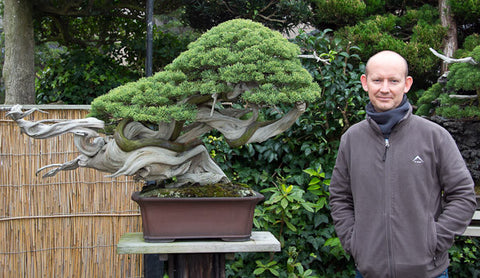
Image caption. This famous Juniper styled and cared for by Master Kimura no doubt receives plenty of fertilizer to remain in pristine health.
8 Responses
Demi Marrufo
April 03, 2018
I have a question regarding fertilizer. I have a small bottle of fertilizer that you put in the plant upsidown to fertilize, and it is not specific about amount, so I was wondering if I leave the bottle in their until I have to replace or take it out during the dormant season.
Careybird
March 07, 2017
Thank you, an extremely well-researched article, well-written and well-presented; I look forward to the next article – power to your pen. KC
Jon
March 04, 2017
Thank you for another great article Terry. Many thanks for taking the time to write these and for sharing your knowledge so freely.
Brett Simon
February 24, 2017
Great article Terry.. Also very well timed.. I had a problem this year due to not feeding last Autumn.. in my opinion most important time to feed. Great article.. look forward to the next
Brett
Joe
February 24, 2017
Hi Terry, Another excellent article. Thank you. I would like to know your opinion in using homemade liquid fertilizers, such as comfrey juice for instance. I’ve used it in the garden, however, I’m a bit afraid to use it on the bonsai as I do not know specific dosage recommendations.
John
February 24, 2017
Very well written and organized Terry. Thanks for taking your time to pull this knowledge, and notes based on your experience, together in an understandable format. You’ve given me plenty of details to think about so I better organize my fertilizing effort.
Hassim Gora Khaki
February 24, 2017
Wow – This is a first class article. I thought I knew how to fertilise but this article provides an in-depth look at the function and really gives insight into the physiology of growing a bonsai with regard to food. I am so thankfull that this information is provided at such a simple level and I know my tress will be the better for it. Thank you Terry – As always you provide great advise and tips. this is yet another super article which can only help to develop the art of bonsai at all levels.
Leave a comment
Comments will be approved before showing up.
Recent Articles
- Enthusiasts Top Wiring Tips July 17, 2023
- Top fertilizing tips March 28, 2023
- Top watering tips February 13, 2023
- Creating Japanese Maple forests October 24, 2022
- How to dig bonsai material August 15, 2022
- How I style bonsai and you can too April 30, 2022
- Swamp Cypress Bonsai Styling July 03, 2021
- How to hide large scars quickly June 14, 2021
- 14 Tips for Field Growing Bonsai May 31, 2021
- Aquaria: An Introduction January 06, 2021

FREE SAMPLE GIVEAWAY!
We are giving away samples of our new product, SuperBoost fertilizer pellets.
A unique organic blend of Blood meal, Bone meal, Canola meal, Fish meal, Fish hydrolysate. Macro, micro and trace minerals. Plant natural stimulating hormones, enzymes and amino acids.





Terry Erasmus
April 10, 2018
Hello Demi. I would love to help you but I am afraid you have given me too little information to go on. I would assume when it is depleted and the bottle is empty you would replace it, but this is a complete guess. How can the fertilizer come with no instructions on use whatsoever?